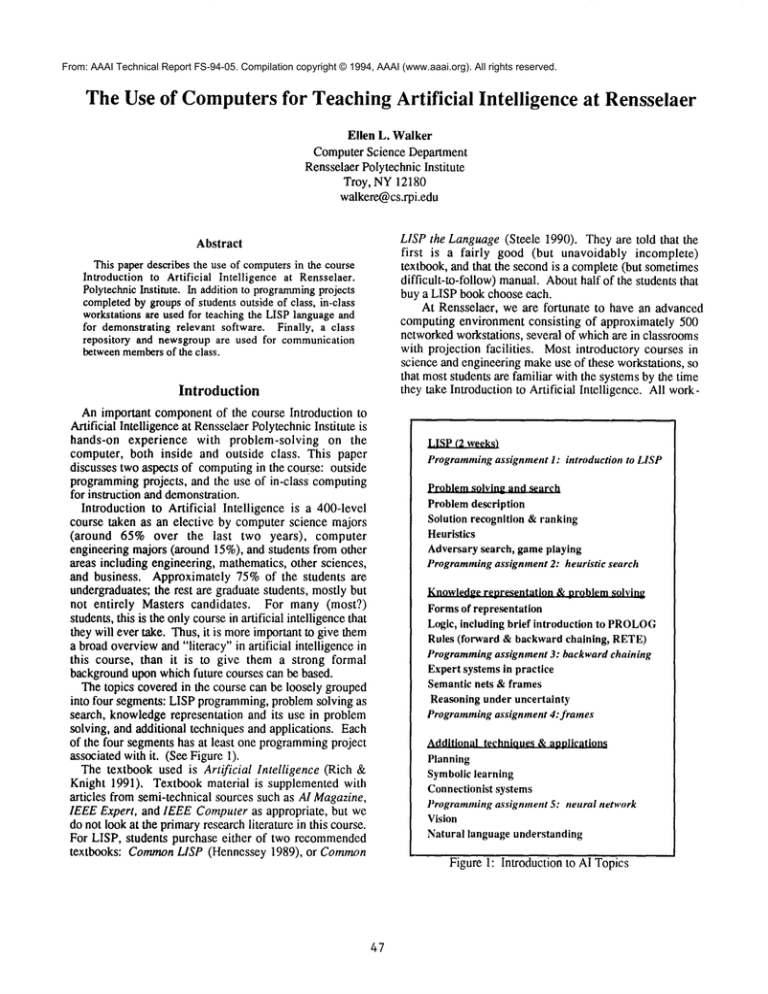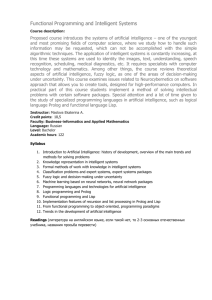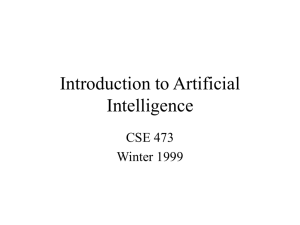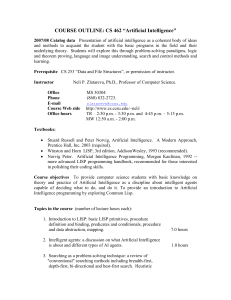
From: AAAI Technical Report FS-94-05. Compilation copyright © 1994, AAAI (www.aaai.org). All rights reserved.
The Use of Computersfor Teaching Artificial
Intelligence
at Rensselaer
Ellen L. Walker
Computer Science Department
Rensselaer Polytechnic Institute
Troy, NY12180
walkere@cs.rpi.edu
LISP the Language(Steele 1990). They are told that the
first is a fairly good (but unavoidably incomplete)
textbook, and that the second is a complete (but sometimes
difficult-to-follow) manual.Abouthalf of the students that
buy a LISP book choose each.
At Rensselaer, we are fortunate to have an advanced
computing environment consisting of approximately 500
networkedworkstations, several of whichare in classrooms
with projection facilities. Most introductory courses in
science and engineering makeuse of these workstations, so
that most students are familiar with the systems by the time
they take Introduction to Artificial Intelligence. All work-
Abstract
This paper describes the use of computersin the course
Introduction to Artificial Intelligence at Rensselaer.
PolytechnicInstitute. In addition to programming
projects
completedby groupsof students outside of class, in-class
workstationsare used for teaching the LISPlanguageand
for demonstrating relevant software. Finally, a class
repository and newsgroupare used for communication
betweenmembers
of the class.
Introduction
An important componentof the course Introduction to
Artificial Intelligence at RensselaerPolytechnicInstitute is
hands-on experience with problem-solving on the
computer, both inside and outside class. This paper
discusses two aspects of computingin the course: outside
programmingprojects, and the use of in-class computing
for instruction and demonstration.
Introduction to Artificial Intelligence is a 400-level
course taken as an elective by computer science majors
(around 65% over the last two years), computer
engineering majors (around 15%), and students from other
areas including engineering, mathematics, other sciences,
and business. Approximately 75% of the students are
undergraduates; the rest are graduate students, mostly but
not entirely Masters candidates. For many (most?)
students, this is the onlycoursein artificial intelligence that
they will ever take. Thus, it is moreimportant to give them
a broadoverviewand "literacy" in artificial intelligence in
this course, than it is to give them a strong formal
backgroundupon which future courses can be based.
The topics covered in the course can be loosely grouped
into four segments: LISP programming,problem solving as
search, knowledgerepresentation and its use in problem
solving, and additional techniques and applications. Each
of the four segments has at least one programmingproject
associated with it. (See Figure 1).
The textbook used is Artificial Intelligence (Rich
Knight 1991). Textbook material is supplemented with
articles from semi-technical sources such as AI Magazine,
IEEE Expert, and IEEE Computeras appropriate, but we
do not look at the primaryresearch literature in this course.
For LISP, students purchase either of two recommended
textbooks: CommonLISP (Hennessey 1989), or Common
47
Programming
assignment1: introduction to LISP
Problemsolving and search
Problemdescription
Solution recognition &ranking
Heuristics
Adversarysearch, gameplaying
Programming
assignment2: heuristic search
Knowledgerepresentation &problem solving
Formsof representation
Logic, including brief introduction to PROLOG
Rules (forward & backwardchaining, RETE)
Programming
assignment 3: backwardchaining
Expertsystemsin practice
Semanticnets &frames
Reasoningunder uncertainty
Programmingassignment 4:frames
Additional techniques &applications
Planning
Symboliclearning
Connectionist systems
Programming
assignment 5: neural network
Vision
Natural language understanding
Figure 1: Introduction to AI Topics
stations have a commonfile system, which includes
departmentdirectories as well as user directories. Thus, all
course-related software, sample programs, and usage
examples is collected into a single course directory,
accessible to all students.
Each semester, I attempt to design a set of programming
projects that span the topics of the course, have a design
component,are relatively fun for the students, and provide
a reasonable mix between asking the students to write
customcode for AI algorithms and to use AI tools that they
were given. In teaching Artificial Intelligence, I have
found that the use of existing code is important to get
students to complete a reasonable project in a reasonable
amountof time. Fromtalking with students in myclass, it
is clear that they have chosen this particular class as
opposedto courses in artificial intelligence offered by other
departments, including philosophy and electrical
engineering, specifically because they knowthat this
course is the one where they will get the most programming experience. Somestudents want the programming
because they enjoy it, while others want projects to add to
their resumes. In any case, the material covered by the
programmingprojects is invariably the material that the
students learn the best, as measuredby exams.
Programming
Projects
Althoughproject time is limited, students master the material better whengiven significant design freedom,beyond
what is often thought of as "modifying existing code".
Thus, in this course, students write completemodulesto be
integrated with given modules into a larger program.
Students are encouragedto work in groups, and each group
reports whocontributed what as part of their project writeup. In this way, strong programmerscontribute more to the
implementation, but even weak programmers contribute
equally to the design. Since design is crucial to the understanding of the various topics, this allows weakprogrammers to get more from the projects than they wouldworking alone, on even an easier project.
The remainderof this section describes the five projects
from the Fall 1993 semester. Except for the first, each
project emphasizeda technique and a problemto solve, and
included somecode to help the students solve the problem,
but not enoughto hampertheir design freedom. In projects
2 and 3, the students were given modulesto link with their
ownto build more interesting systems than they could
otherwisedo in the allotted time. For projects 4 and 5, the
provided code was in the form of tools for the students to
use rather than customized modules. In this way, the
students were given experience with the kind of tools that
artificial intelligence professionals might be expected to
use.
Project 1 -- Introduction to LISP
The first project was designed to give each student a
basic understanding of the LISPprogrammingstyle and the
use of recursion as a programmingparadigm. Unlike the
remaining projects, no code was given, and the students
were required to work alone. The students were asked to
recursively determinethe completeset of prerequisites for
courses, given the catalog specifications for individual
courses. Essentially, the students had to determine the
transitive closure of a prerequisite graph.
Althoughthe project was short and simple, it introduced
the students to two essential features of LISP: recursive
procedures and property lists (used to store the catalog
information). Additionally, students were encouraged to
use the interactive debugger to understand their programs
so that they would be able to use them to debug more
complexprojects later.
Project 2 -- Adversary Search
For the second project, the technique was adversary
search. The students were given the code necessary to play
a game(Dots), exclusive of the control portion to choose
the next move.Using this infrastructure, their job was to
write the control portion for an automatic dots-playing
program. Included in the given code was a "dummy
program" that allowed a human to play against the
machine. Part of the grading process was to run a
tournament amongthe student programs for extra credit
points.
Oneof the advantages of this assignmentwas that it was
clear to the students that their part of the project wasto add
"intelligence"
to a dumb game-playing program. The
competitive nature of the assignment added to the
enthusiasmwith which it was received.
I wrote the code for Dots, and similar code for Klondike
solitaire. In each case, the codeincluded the necessary data
structures to represent the playing field, a function to
perform each type of move, a function to check move
legality, and a top-level function to play the game,calling
the players’ control functions alternately in the case of dots,
repeatedly in the case of solitaire. I would be happy to
makethis code available to others whoteach AI if they feel
it wouldbe helpful.
Project 3 m Backward Chaining
For the third program, the technique was backward
chaining. Students were given a unification procedure and
a library to handle variables, and were required to write a
backward chainer for deductive retrieval. Rules for a
sample domain(family relationships) were given, but
part of the assignment, each team had to apply their
reasoner to their owndomainand set of rules. Thus, the
students first had to develop an AI tool (the reasoner), and
then use it (by creating their ownrules and facts).
The unification procedure and variable library were
adapted from code in an FTPrepository provided by Kevin
Knight to accompanythe textbook, Artificial Intelligence.
In general, I have found this FTPrepository quite useful,
and would highly recommendit to others using the book.
The neural network backpropagation simulator, used in
project 5, also camefromthis repository.
Project 4 -- Frame Representation
The technique addressed in the fourth programwas using
frames as a representational tool. Students implementeda
simplified story-understanding program, using the Framekit
frame system. Students were given the Framekit system
(and manuals), and were required to design frames
understand stories about going to the movies. Since the
representation was the mainpoint of the project, they were
allowedto translate the stories into frames by hand, but the
answers to the questions had to be extracted automatically
from the frames. Given more time, a natural extension to
this project wouldbe to apply natural language techniques
to automaticallytranslate the stories to frames.
This project was primarily a design project; the students
generally wrote very little code, although their frames were
extensive. Becauseof the open nature of the assignment (a
frame for "seeing movies" that could encompass several
stories, including one wheretwo people rented a video and
watchedthe movieat home), there was the greatest variety
of solutions to this project. The students, as users of the
given frame system, were forced to discover its advantages
and limitations, and design their software accordingly.
This experience is probably closer to what manyof them
might do after graduation than writing customcode. It also
gave them a chance to use a muchmore complex tool than
they could have written, and served as a contrast with the
mini-deductiveretriever that they wrotefor project 3.
The frame system used was FrameKit, version 2.0, from
Carnegie Mellon University (Nyberg 1988). I received
FrameKit as part of the VANTAGE
modeling system that I
use for myresearch. FrameKit is a fairly complete frame
system, but does not have the nice additions (e.g. graphical
specification) that manycommercialsystems have. Onthe
other hand, it did not require special hardwareto run, and
was already available on the systems used in class. I would
be interested in evaluating other representation systems
based on Common
LISP (so that students can add their own
demonsto frames).
Project 5 - Neural Nets
The final project was a hands-on experience with neural
networks. The students were given a complete database of
all possible tic-tac-toe gamesand their outcomes,and the
network was to learn to recognize a game wonby X. The
students used a backpropagationsimulator, and were asked
to experiment with different network topologies and
training / test sets to see howthe learning was affected.
Students were also asked to analyze the activities of the
hidden nodes to try to determine what features were being
learned.
This project was done at the end of the semester, when
most of the students were at their busiest, and there was not
muchtime for the assignment. Thus, the goal was to give
as much hands-on experience with neural networks as
possible, without overloading the students. By structuring
49
the project more as a lab exercise than a programming
project (but still with a design component), the goal was
met. The students developed a good sense of howneural
networkslearn, and not incidentally, howlong it can take!
Like the frame project, this one gave them a sense of how
AI technologyis used.
In-Class
Computing
For the Fall of 1993, Introduction to Artificial
Intelligence was taught in one of the classrooms at
Rensselaer that has a built-in UNIXworkstation and
projector. Althoughthis classroomwas one of the first, an
increasing numberof classrooms are being equipped in this
manner. The classroom equipment was invaluable,
especially when teaching LISP at the beginning of the
semester, and when introducing each of the programming
projects.
In the Fall of 1994, the class is again scheduled in the
same classroom. This year, we plan to increase the use of
the projection facilities to include in-class demonstrations
of existing AI programsand interactive tools that students
can later use on their own to help understand concepts
presented in the course. An exampleof an interactive tool
is described in (Vastola & Walker1994).
In-Class Introduction of LISP
The in-class workstation was a perfect tool for the
introduction of LISP. Instead of using handouts showing
what to type and what would happen, I was able to open a
windowon the workstation, start up LISP, and run through
a live sequence of examples. The class sessions basically
followed the sequencing of the recommended LISP
textbook (Hennessey 1989), but was able to vary based
students’ interaction during class. This format was much
more lively than my traditional overhead slides, and
students were much more involved in the class. Even
typographical errors were chances to introduce facets of
LISPsuch as the error-handling facilities and the debugger.
A log of each classroom session was saved in the class
directory for students to review at their leisure. Example
files (both those loaded during a session and those created
during a session) were also saved in the class directory.
Thus, students were freed from taking notes during the
demonstrations, so they could more fully participate in
class. To emphasizeimportant points and help to organize
the log, I typed LISP comments.
I spent the sameamountof classroom time on LISP as in
previous semesters, but found that with the live
presentation I could cover more material and the students
were able to retain more. This semester there were fewer
commentsabout the overload of material during the LISP
unit than in past semesters.
Support for Programming Projects
Exceptfor the first programming
project, whichis a selfcontained practice problem for getting started with LISP,
each programmingproject included significant code, and
the students neededonly to write the portion that was most
relevant to the technique being studied, The in-class
workstation was invaluable for introducing the "given"
portions of each problem.
On the day each program was introduced, the relevant
code was presented in-class. Wheneach project was introduced, the relevant software was explained and demonstrated in class. For the game-playingproject, the demonstrated software included "dummy
code" for the controller
so that actual games could be demonstrated. Other software, including the unification procedure and Framekit,
was demonstrated using sample data. In all cases, the
sample data or dummycode was made available in the
course directory for students to peruse on their own.
Additional Program Demonstrations
This year, I plan to add two more uses of the in-class
workstation. The first is to include demonstrationsof some
of the increasing numberof artificial intelligence systems
and tools that are becomingavailable over the Internet, as
well as demonstrating examplesof current research. (One
of mygoals in attending this workshopis to learn more
about what software is available for demonstration.) The
seconduse of the workstation is to incorporate interactive
tools that help students understand concepts presented in
class. The first exampleof such a tool will be used this
year (Vastola &Walker 1994).
The Course Newsgroup
One feature provided to all courses at Rensselaer is a
newsgroupin the rpi.courses hierarchy. The Introduction
to Artificial Intelligence newsgroup,rpi.courses.ai, was
used by the professor and TAfor distributing late-breaking
information on the course such as errors in handouts,
extensions on projects, and changes in office hours. The
newsgroup also provided a forum for students to ask
5O
questions about course topics and for students to contact
each other for course-related purposes, such as setting up
project teams and study groups. At the end of the semester,
the newsgrouparchive was a record of these discussions,
allowing for better planning for future semesters.
Conclusions
The students’ experience in the course Introduction to
Artificial Intelligence is enhancedby the use of computers,
both in the classroomand for special projects. By allowing
the students to incorporate existing code in their own
designs, the projects can be both interesting and do-able in
the time allotted. The in-class workstation and class
repository allow programming-oriented instruction in a
more enjoyable and intensive manner, as well as allowing
live demonstrations of existing artificial intelligence
applications and pedagogicaltools.
References
Hennessey, W.L. 1989. CommonLISP. New York, NY:
McGrawHill.
Information Technology Services. 1993. ITS Computing:
A guide, Internal Publication, Rensselaer Polytechnic
Institute.
Nyberg, E.H. 1988. The FrameKit User’s Guide Version
2.0. Technical Report, CMU-CMT-88-107,Center for
MachineTranslation, Carnegie MellonUniversity.
Rich, E. and Knight, K. 1989. Artificial Intelligence (2
ed.). NewYork, NY: McGrawHill.
Steele, G.L., Jr. 1990. CommonLISP the Language.
Bedford, MA:Digital Press.
Vastola, D.A. and Walker, E.L. 1994. Interactive
Learning Tool for Statistical Reasoningwith Uncertainty.
In these proceedings.






